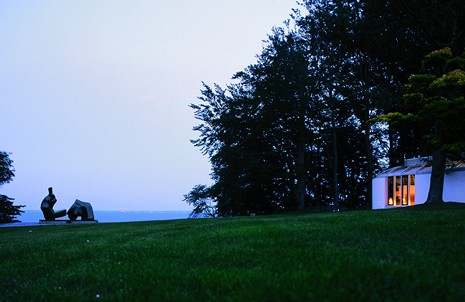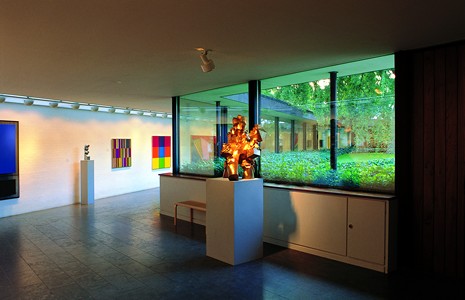Description
The architects commissioned by Knud W. Jensen had to take into account two significant factors. The new building had to harmonize well with the nineteenth-century country house to which it was to be attached. He had acquired it, together with a park high above the Øresund with a small lake and old trees, in order to erect a museum there for his private art collection. Above all, however, the museum was to be designed in such a manner that it exploited to the full the beauty of the park without destroying it. During no less than eight building phases over the course of more than forty years, Jørgen Bo and Vilhelm Wohlert have remained true to the basic principle of keeping nature, architecture and art in balance.
The concept was to make art experienceable in an unceremonious way in a more or less everyday environment. For that reason, the new museum was to be like a large country house, friendly, rustic, with whitewashed walls, wood and clinker brick, and open to the park. Erected in the first phase, the three pavilions of the southern wing, inspired by the traditional Danish architecture, but also by Japanese and American architecture, were sensitively integrated into the landscape and linked via glass passageways with frequent bends to the old building, which functioned as the entrance. The variation between views and concentrated interior spaces, the avoidance of longer view axes, and the natural lighting by means of overhead and lateral light only supplemented occasionally with spotlights assured the museum exceptional acceptance.
In 1966 and 1971 extensions for temporary exhibitions were added to the northern wing, and in 1976 a concert hall and event venue was added to its end. A new exhibition wing in the southern wing was opened in 1982, this time as a row of diagonally placed rooms set next to each other, closed off to the outside and illuminated by somewhat more sophisticated overhead lighting structures. In 1991, Vilhelm Wohlert’s son Claus designed the subterranean wing for prints, which is accessible via a conservatory. It links the two wings with each other and thus enables a complete circular tour of the museum. In addition to a café and a children’s museum, a new museum shop was built in 1998; it shall soon be followed by an extension for a “House of Twentieth-Century Architecture” planned by Jørn Utzon.
Arkitektur DK 5/1958, pp. 145-165 (Kay Fisker); 7/1982, pp. 253-273; 4/1989, pp. 184-187 (Lisbet Balslev Jørgensen); and 7/1991, pp. 309-321 (Thomas Kappel) • Roberto Aloi, Musei. Architettura – Tecnica, Milan, 1962, pp. 92-100 • Michael Brawne, The New Museum, New York/Washington, 1965, pp. 80-83 • Baumeister 3/1979, pp. 258-259 • Progressive Architecture 8/1983, pp. 82-87 (John Morris Dixon) • Laurence Allégret, Musées, Paris, 1987, pp. 54-61 • Knud W. Jensen, Mein Louisiana-Leben. Werdegang eines Museums, Klagenfurt, 1991 • Michael Brawne, Jørgen Bo, Vilhelm Wohlert. Lousiana Museum, Humlebæk, Tübingen/Berlin, 1993 • Detail 8/2000, pp. 1450-1454 (Heide Wessely)
Drawings
Axonometric view of entire complex (1982)
Ground floor with surroundings
Cross sections from top to bottom: Exhibition rooms in the north wing (1958), Exhibition rooms in the south wing (1982), Subterranean print wing (1991)
Stage by stage development of the museum, from upper left to lower right: 1958, 1966, 1976, 1982, 1991
Photos

View of the Øresund from the entrance; on the right, the print wing

Connecting passage between the entrance and the south wing (1982)
Originally published in: Paul von Naredi-Rainer, Museum Buildings: A Design Manual, Birkhäuser, 2004.